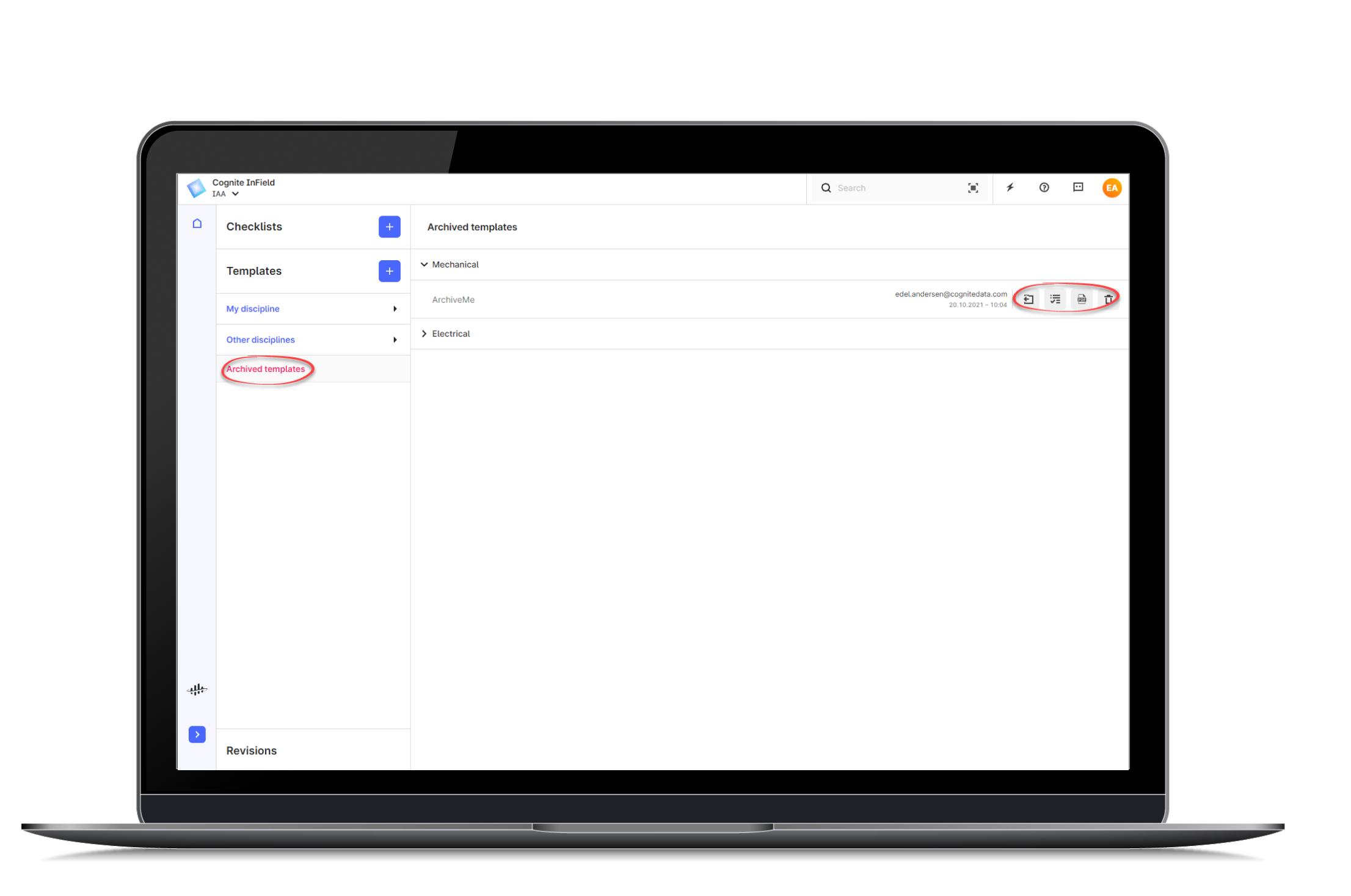Checklists for routine rounds
With additional access rights, you can create templates for checklists for daily, weekly, and monthly routine rounds.
You can populate a template with fields for adding measurement readings, additional checklist statuses and instruct InField to open daily checklists for selected disciplines. You can group items that belong together in layers of sections to granulate the checklist and checklist reports.
Step 1: Consider what type of checklists you want to create
The selections you make in the Template settings determine the content of the checklists based on the template and how you can share checklists between co-workers.
Templates without intervals
Use this template if you want to create unique one-time checklists that don't necessarily fit into a set schedule or a separate checklist you want to keep recreating outside the routine round work.

Select Create template without intervals. By default, these checklists are only open for the user who created the checklist, but you can share with Share checklist in the More options (...) menu. Other users can't join these checklists.
InField appends the date to the checklist name and a chronological number in parenthesis if the checklist is already created.
Template with intervals
Use this template for teams doing a week's work together. This is the default template.

Clear Create template without intervals to create checklists for a week with time intervals for work shifts and days for execution. For instance, for routine rounds made every 2, 3, or 4 weeks. The checklists from this template are available for all users to join. The checklist users can navigate to a template and select Open checklist or select Join checklists via a URL shared by a co-worker.
Templates for automatic opening of daily checklists
Use this template for recurring checklists that will be distributed to all users within a selected discipline at the same time every day by a manager. Users won't need to navigate to a template and select Open checklist.

Select Automatically open daily checklists for selected disciplines and then select the disciplines that will have checklists automatically appear in the My checklists panel at the schedule set in the template. Note that this option doesn't cater to checklists for individual users unless you share the checklist using Share checklist in the More options (...) menu.
This template doesn't include intervals since the checklists are created per day and not on a weekly schedule.
You can pause and resume the schedule with Toggle automatic opening of checklists. This setting is, by default, turned off. The initial start time is 6 AM in the computer's local time zone. You can change the start time to one-hour intervals.
Make sure you've completed the template and it's ready for rolling out to the checklist users before you turn on Toggle automatic opening of checklists.
A label on the template indicates if checklists are automatically opened:
- If the label shows a time, checklists open automatically. The toggle is turned on.
- If the label shows Pause, no checklists automatically open. The toggle is turned off.
Combine automatic opening of checklist with shift work
If you're creating templates with automatic opening of daily checklists for shift work, you'll need to create one template for each shift:
- Turn off Toggle automatic opening of checklists.
- Duplicate and edit the template.
- Turn on Toggle automatic opening of checklists when you're ready to roll out the checklist to the set disciplines.
Step 2: Define the template
-
Select Plus (+) next to Templates to open Create template.
-
Enter a template name and select one or more relevant disciplines.
-
Select Add measurement readings to template to add gauge readings to any checklist created from the template. You can specify different input types and minimum and maximum values when you create a task in the template.
-
Select Automatically open daily checklists for selected disciplines to schedule a time when checklists from this template are automatically opened for all users within the selected discipline. You can pause and resume this option by turning on and off Automatic checklists is active.
-
Add different checklist states with the checkboxes under More options. To do and OK are always included.
Step 3: Set work shift and days for execution
-
Add tasks. Note these text layout tips for the template items.
-
Type some text and then insert a colon. This text will be in bold format.
-
Tag IDs and asset names are blue and link to the tag or asset.
-
Click Shift + Enter to insert a line break.

-

- Specify a shift in Select interval. Choose Advanced scheduling to set the weekly frequency. This option enables you to create templates for rounds made every 2, 3, or 4 weeks. When you create a checklist from this template, the checklist elements are placed in the assigned weeks.
You can't specify shifts if you've created a template with automatic opening of daily checklists.
- Specify days for execution.
Step 4: Add measurement information
-
Enter the name of the reading. The name must be unique and descriptive, as these will be available on the Trend page. Keep the name short for best viewing on the mobile device. Any tag used in the checklist element is prefixed to the name.
-
Select if the readings should be Low, Normal, High, or In, Out, Up, or numerical values. You can predefine numerical values with minimum and maximum limits. When the checklist users adds readings within this value range, the task is automatically set to OK. Readings outside the value range are automatically set to Not OK. Checklist users can manually select another status. If you don't add minimum and maximum values, the task is set to OK when you enter measurement readings.
CautionA system error sometimes prevents InField from saving templates with many measurement readings. To avoid losing data, create a duplicate template as a backup. Select Duplicate template from the More options menu (...). You can create a new template based on this backup.
If the system error causes issues when saving a template, it may create a checklist without measurement readings. Use the backup template to create a checklist manually with Open as checklist.
Step 5: Create checklist sections
Sort checklist items into sections:
- Select Create section.
- Enter a section title. Optionally, format the text using the layout tips.
- Select Enter to confirm.
- Drag the checklist items as an indent under a section title.
You can add layers of sections within sections to granulate the checklist structure.
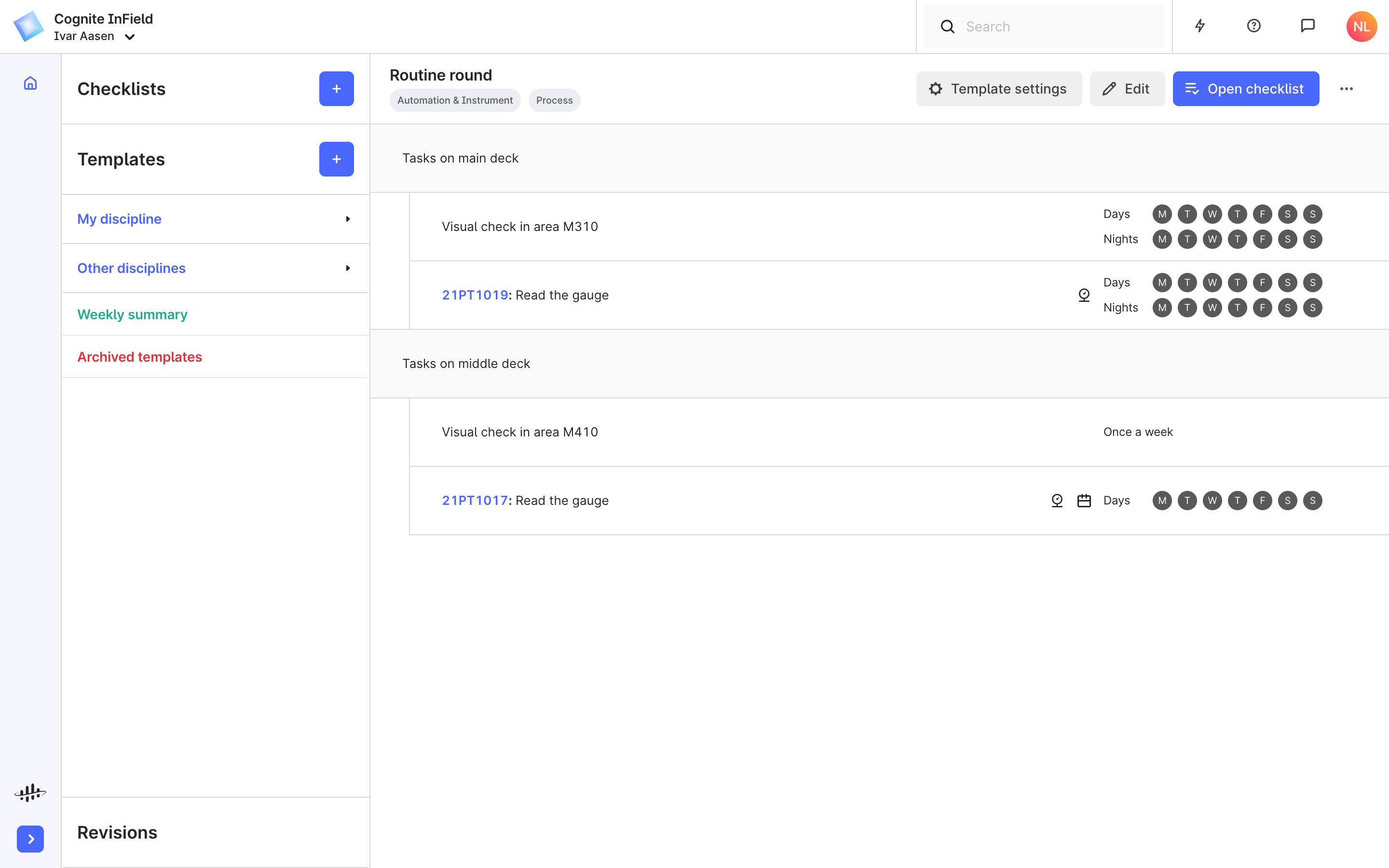
Step 6: Create checklists based on templates
When you've added all items to a checklist, select Confirm to create the template and Open checklist to create a checklist from the template. A checklist contains tasks for seven days. Day 1 is the first Monday after you created the checklist. You'll see the week number together with the checklist name.
Step 7: Use checklists for routine rounds
You'll see the checklists based on templates as open checklists on the same name as the template they're based on and the week number for execution. Note that you can't edit these lists.
-
Check off and select a status for the checklist tasks. You can set the same status for all remaining tasks in the checklist or per section with Mark remaining tasks as... under More options (...).
-
Add measurement readings if your admin added this to the template. If min. and max. values are preset, any deviations have a red line, and the task is automatically set to Not OK. You can override this by manually selecting another status. If a measurement reading isn't preset with min. and max. values, the task is set to OK when you enter any measurement reading. You can't add numerical values if
InFieldis offline.tipIf you're running
InFieldfrom an iPhone or iPad, set decimal points in a measurement reading by tapping +*# followed by Pause on the device's numerical keyboard.noteYou can't add numerical values if
InFieldis offline. -
Add comments and images with the menu items under More options (...) for every task.
-
Share the list with co-workers, place your instance of the checklist in the archive, and download a PDF report with the menu items under More options (...) placed in the top right corner of the checklist.
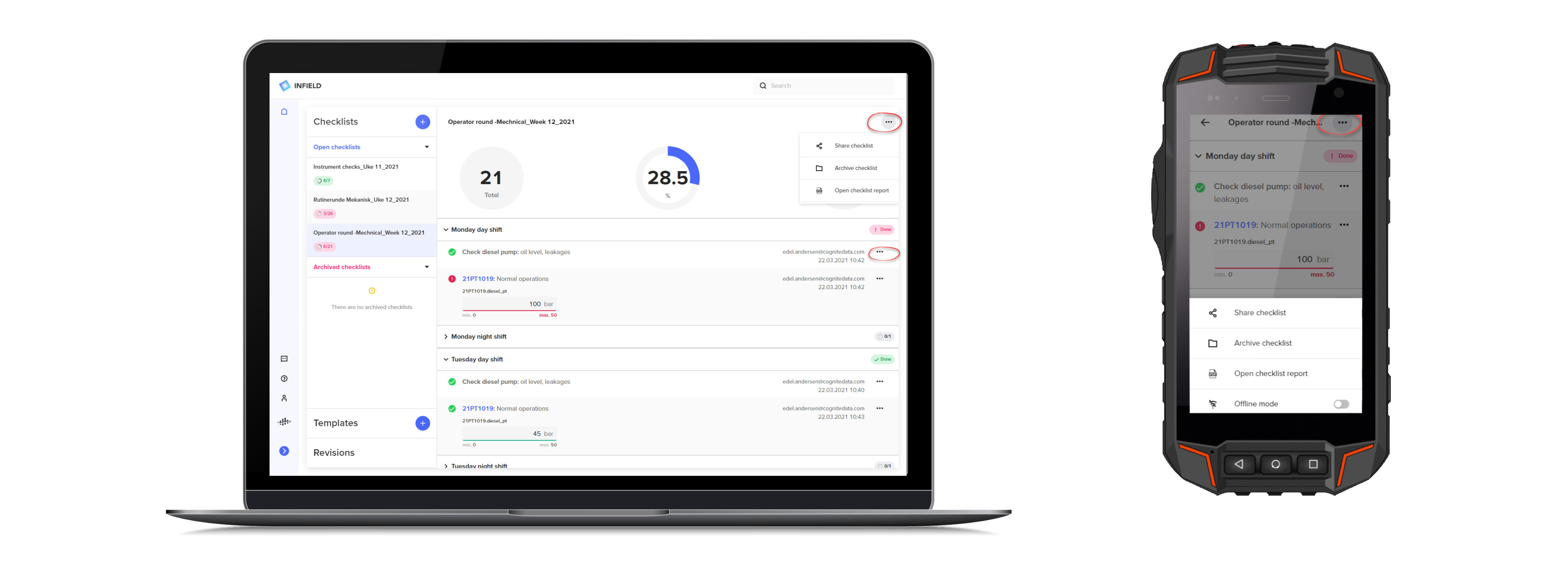
Step 8: Open checklist reports
You can open and print standard or detailed PDF reports from checklists with the menu items Open standard report or Open detailed report placed under More options (...) on a checklist. The standard report shows the checklist task's status and any measurement readings. The detailed report also includes the name and date for the last status change and any comments added to a checklist item.

You can view all checklist reports from the same template with the menu item Historical reports for this template on the Templates page. This page displays all checklists generated from the template. To open a report for each checklist, select Standard report or Detailed report on the checklist row to open a PDF file you can print.
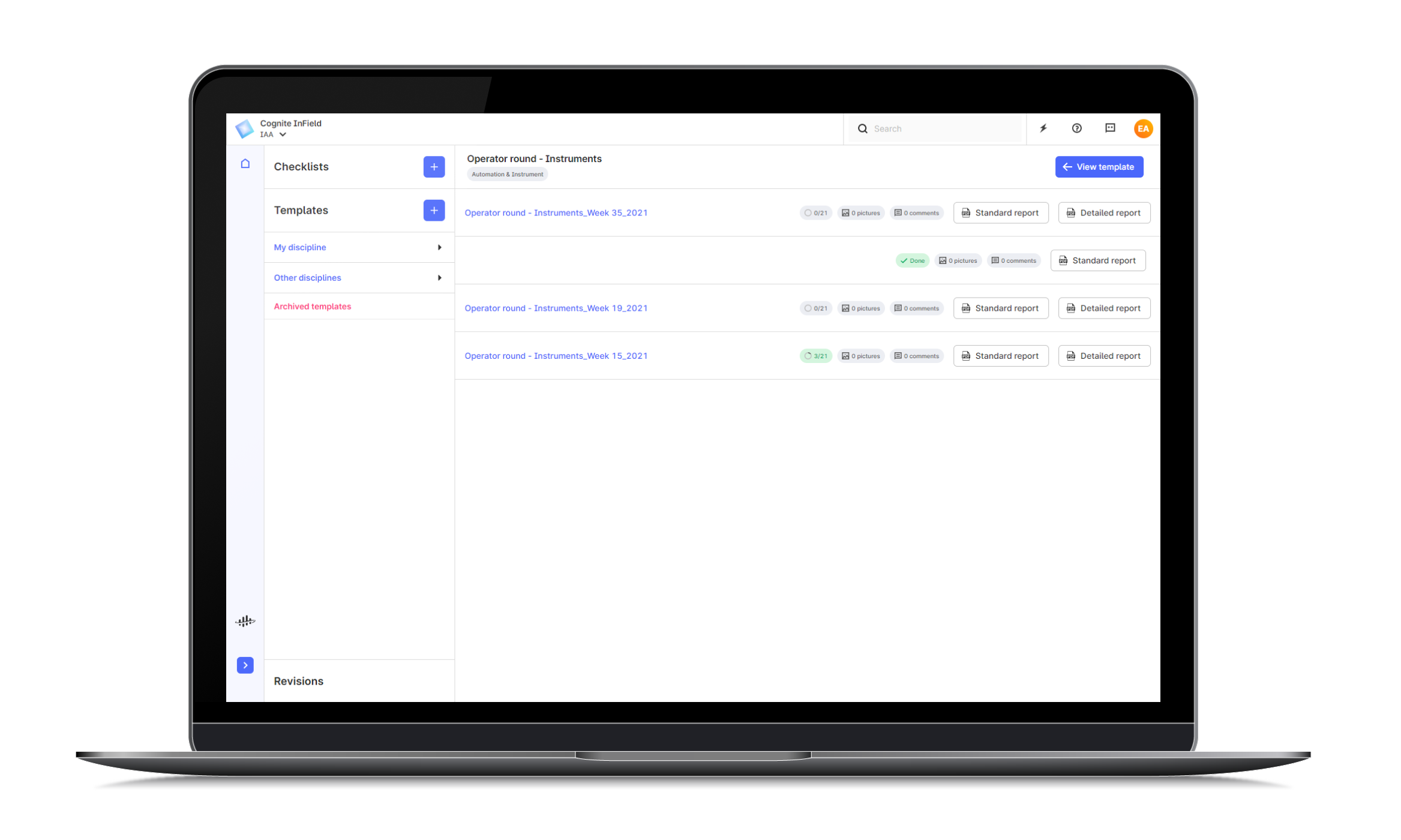
On a mobile unit, you can view the standard reports only by selecting the PDF icon on the right side of a checklist item.
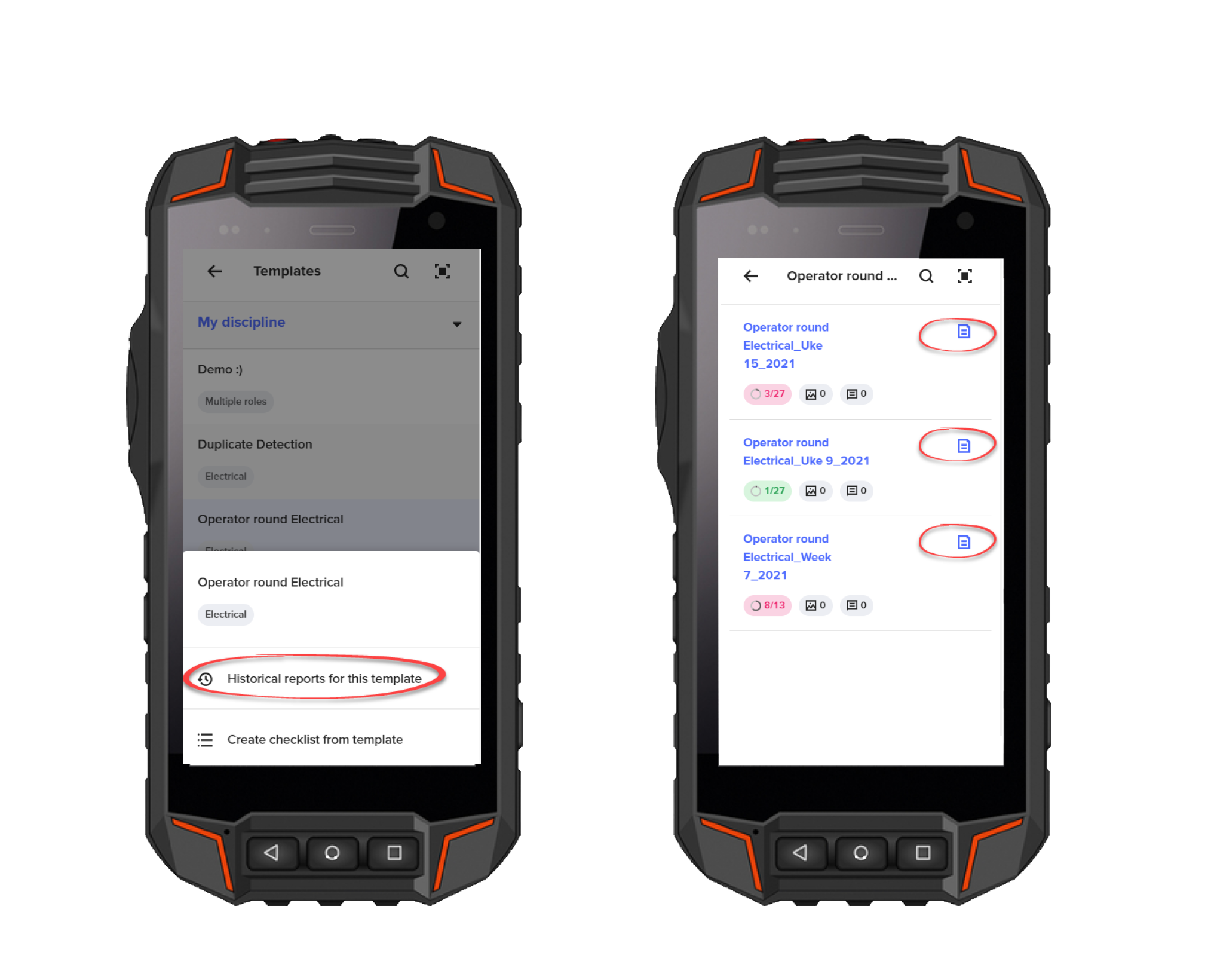
Step 9: Archive templates
You can archive templates if you run InField from a desktop and have extended rights in the InField settings. Select Archive template under More options (...) on the Templates page to move a template into the Archived templates section. Here, you'll find the templates sorted according to the area of expertise. On this page, you can open, restore or delete the template. You can also view any reports based on checklists from the template. If you delete the template, the checklist reports will no longer be available. Make sure to download the reports you want to keep.
